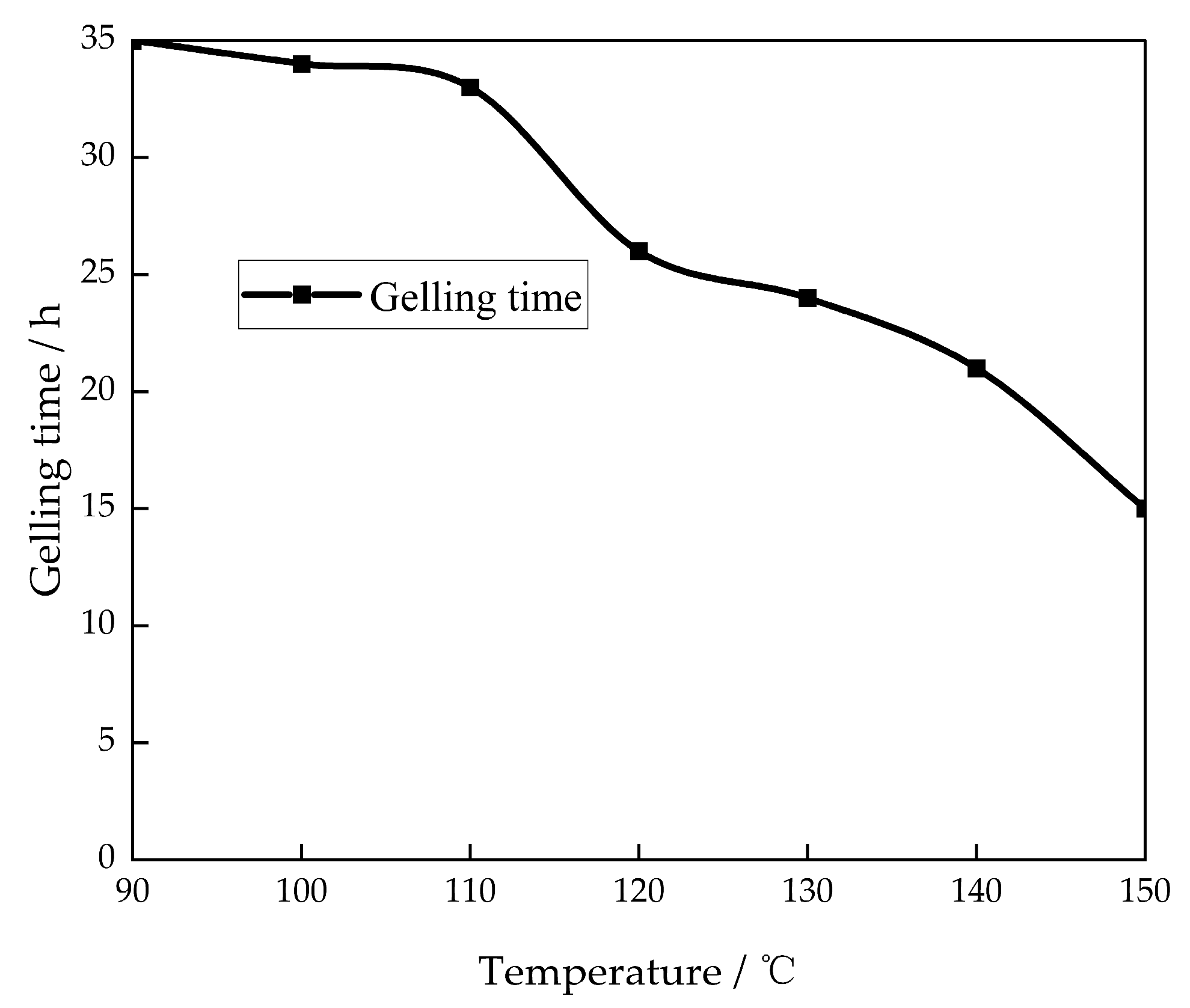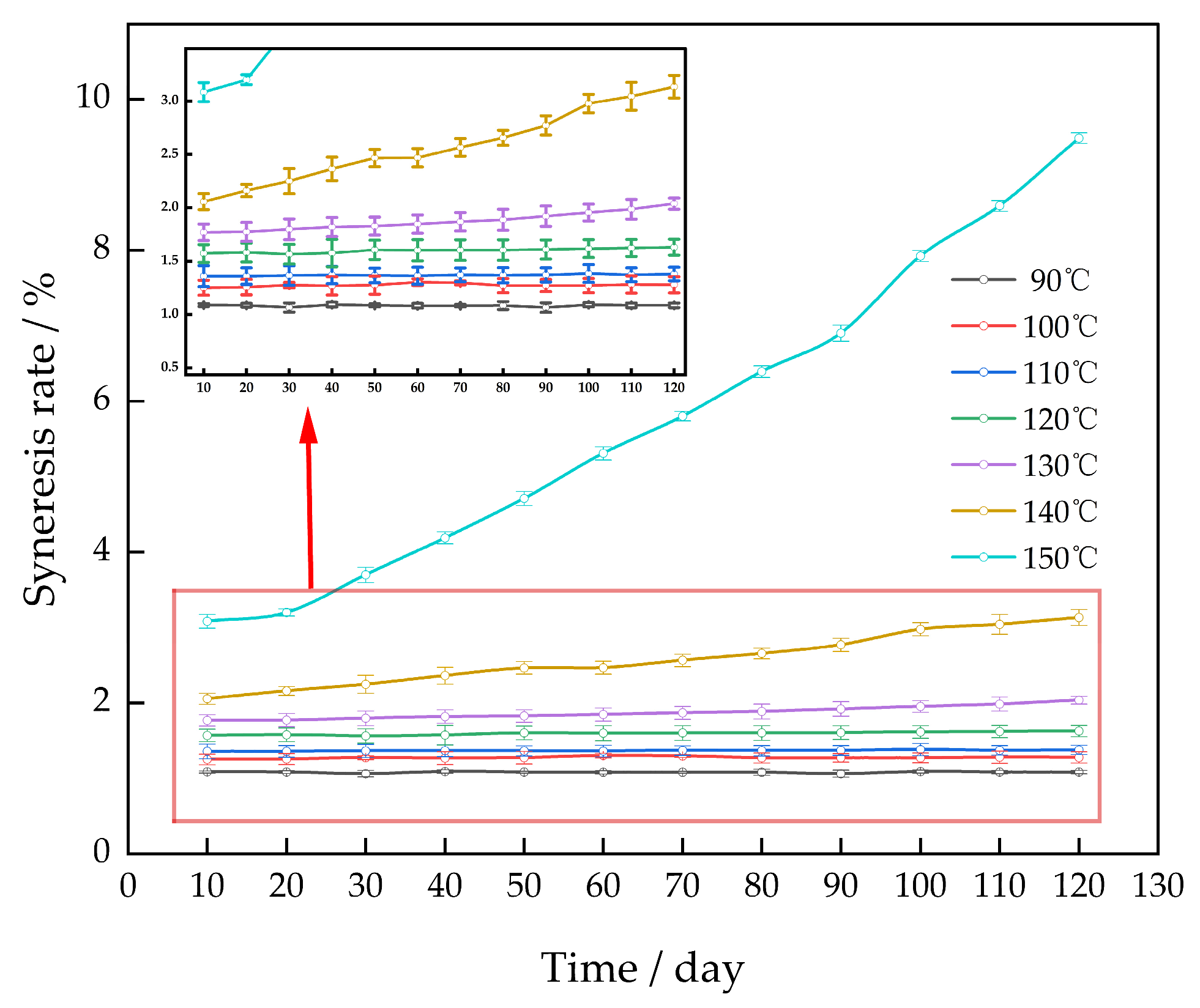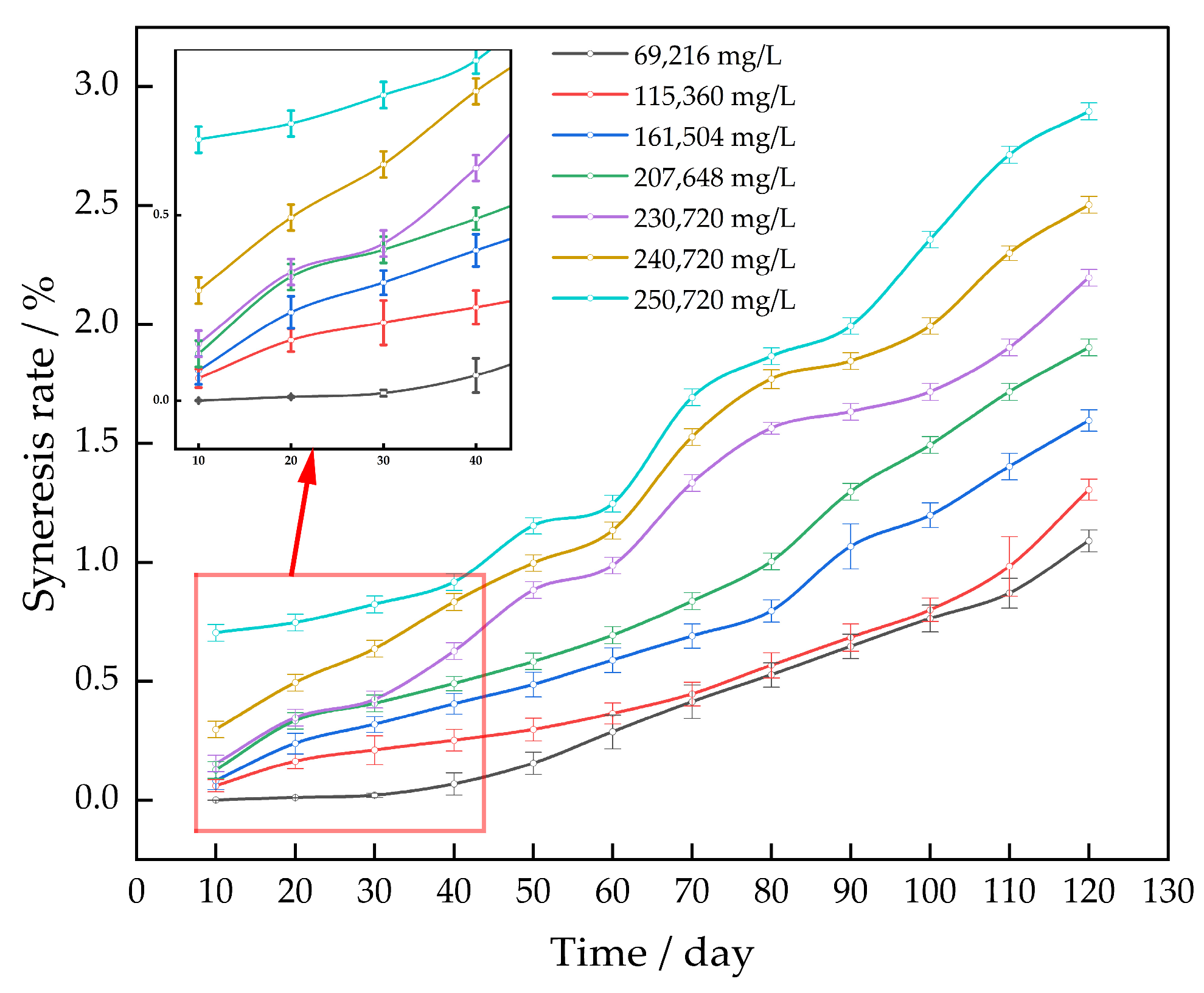Preparation and Performance Evaluation of Temperature-Resistant and Salt-Resistant Gels
Abstract
1. Introduction
2. Results and Discussion
2.1. Synthesis of a Novel Heat- and Salt-Resistant Gel Plugging Agent
2.1.1. Optimization of Polymer Dosage
2.1.2. Optimization of Cross-Linking Agent Dosage
2.1.3. Optimization of Stabilizer Dosage
2.1.4. Determination of Gelling Time
2.2. Performance Evaluation of a Novel Heat- and Salt-Resistant Gel Plugging Agent
2.2.1. Temperature Resistance Performance Evaluation
2.2.2. Salt Tolerance Performance Evaluation
2.2.3. Plugging Performance Evaluation
2.2.4. Gel microstructure Characterization
3. Conclusions
4. Materials and Methods
4.1. Experimental Supplies
4.2. Experimental Apparatus
4.3. Experimental Method
4.3.1. Preparation of the AM/AMPS Copolymer
4.3.2. Preparation Method of Temperature-Resistant and Salt-Resistant Gel
4.3.3. Determination of Gel Syneresis Rate
4.3.4. Determination of Gel Strength
4.3.5. Blocking Performance Test
Author Contributions
Funding
Institutional Review Board Statement
Informed Consent Statement
Data Availability Statement
Conflicts of Interest
References
- Xin, X.; Liu, Q.; Liu, S.; Yu, G.; Wan, Q. Optimization of Gel Flooding during the High Water Cut Stage in a Conglomerate Reservoir of the Xinjiang A Oilfield. Polymers 2023, 15, 1809. [Google Scholar] [CrossRef] [PubMed]
- Jiwei, W.; Kaoping, S.; Qianru, L. Deep Plugging Experiments Study in High Temperature and Salinity Heterogeneous Clastic Reservoir. Open Pet. Eng. J. 2016, 9, 216–224. [Google Scholar]
- Lei, S.; Sun, J.; Lv, K.; Zhang, Q.; Yang, J. Types and Performances of Polymer Gels for Oil-Gas Drilling and Production: A Review. Gels 2022, 8, 386. [Google Scholar] [CrossRef] [PubMed]
- Wu, W.P.; Hou, J.R.; Qu, M.; Yang, Y.L.; Zhang, W.; Wu, W.M.; Wen, Y.C.; Liang, T.; Xiao, L.X. A novel polymer gel with high-temperature and high-salinity resistance for conformance control in carbonate reservoirs. Pet. Sci. 2022, 19, 3159–3170. [Google Scholar] [CrossRef]
- Wu, Q.; Ge, J.; Zhang, G.; Guo, H.; Zhao, Q. The water shutoff simulation experiment using tube for high-strength plugging agent in fractured reservior. Acta Pet. Sin. 2019, 40, 1368–1375. [Google Scholar]
- Zhu, D.Y.; Deng, Z.H.; Chen, S.W. A review of nuclear magnetic resonance (NMR) technology applied in the characterization of polymer gels for petroleum reservoir conformance control. Pet. Sci. 2021, 18, 1760–1775. [Google Scholar] [CrossRef]
- Sagbana, P.I.; Abushaikha, A.S. A comprehensive review of the chemical-based conformance control methods in oil reservoirs. Petrol. Explor. Prod. Technol. 2021, 11, 2233–2257. [Google Scholar] [CrossRef]
- Daoyi, Z.; Baojun, B.; Jirui, H. Polymer Gel Systems for Water Management in High-Temperature Petroleum Reservoirs: A Chemical Review. Energy Fuels 2017, 31, 13063–13087. [Google Scholar]
- Sengupta, B.; Sharma, V.P.; Udayabhanu, G. In-situ gelation studies of an eco-friendly cross-linked polymer system for water shut-off at high temperatures. Energy Sources 2014, 36, 1445–1467. [Google Scholar] [CrossRef]
- Wang, Z.; Baojun, B.; Xindi, S.; Jiang, W. Effect of multiple factors on preformed particle gel placement, syneresis, and plugging performance in partially open fractures. Fuel 2019, 251, 73–81. [Google Scholar] [CrossRef]
- Zhang, L.; Khan, N.; Pu, C. A New Method of Plugging the Fracture to Enhance Oil Production for Fractured Oil Reservoir using Gel Particles and the HPAM/Cr3+ System. Polymers 2019, 11, 446. [Google Scholar] [CrossRef] [PubMed]
- Li, Z.Y.; Li, X.G.; Du, K.; Liu, H.K. Development of a new high-temperature and high-strength polymer gel for plugging fractured reservoirs. Upstream Oil Gas Technol. 2020, 5, 100014. [Google Scholar] [CrossRef]
- Bai, Y.; Shang, X.; Wang, Z.; Zhao, X. Experimental study of low molecular weight polymer/nanoparticle dispersed gel for water plugging in fractures. Colloids Surf. A Physicochem. Eng. Asp. 2018, 551, 95–107. [Google Scholar] [CrossRef]
- Liu, J.; Zhong, L.; Wang, C.; Li, S.; Yuan, X.; Liu, Y.; Meng, X.; Zou, J.; Wang, Q. Investigation of a high temperature gel system for application in saline oil and gas reservoirs for profile modification. J. Pet. Sci. Eng. 2020, 195, 107852. [Google Scholar] [CrossRef]
- Jiang, Q.; Xu, P.; Xu, J.; Hou, M.; Liu, Q.; Dai, B. Preparation and Evaluation of Composite Hydrogel for Reducing the Leakage Rate of Lost Circulation. Polymers 2023, 15, 4218. [Google Scholar] [CrossRef] [PubMed]
- Bin, H.; Weisen, Z.; Quan, Z.; Cheng, F.; Shibo, H. Preparation and Experimental Study of a Low-Initial-Viscosity Gel Plugging Agent. ACS Omega 2020, 5, 15715–15727. [Google Scholar]
- Lv, D.; Li, J.; Bo, Q.; Xie, Z.; Dai, C.; Zhao, G. A Novel Profile Control Agent in High-Temperature and High-Salinity Reservoirs: Dispersed Particle Gel Prepared from Modified Nanographite-Strengthened Bulk Gel. Energy Fuels 2023, 37, 19487–19498. [Google Scholar] [CrossRef]
- Kang, W.; Wang, J.; Ye, Z.; Gu, G.; Li, W.; Yang, H.; Li, Z.; Xu, H.; Lv, Z.; Sarsenbekuly, B. Study on preparation and plugging effect of sawdust gel particle in fractured reservoir. J. Pet. Sci. Eng. 2022, 212, 110358. [Google Scholar] [CrossRef]
- Ran, Y.; Zhang, G.; Jiang, P.; Pei, H. Study on Water-Soluble Phenolic Resin Gels for High-Temperature and High-Salinity Oil Reservoir. Gels 2023, 9, 489. [Google Scholar] [CrossRef]
- Zhi, J.; Liu, Y.; Chen, J.; Bo, L.; Qu, G.; Jiang, N.; He, W. Preparation and Performance Evaluation of a Temperature and Salt Resistant Hydrophobic Associative Weak Polymer Gel System. Molecules 2023, 28, 3125. [Google Scholar] [CrossRef]
- Sun, L.; Han, Q.; Li, D.; Zhang, X.; Pu, W.; Tang, X.; Zhang, Y.; Bai, B. Water Plugging Performance of Preformed Particle Gel in Partially Filled Fractures. Ind. Eng. Chem. Res. 2019, 58, 6778–6784. [Google Scholar] [CrossRef]
- Li, X.; Fu, M.; Liu, J.; Xiao, Q.; Tang, W.; Yang, G. Synthesis and Performance Evaluation of a Novel Heat and Salt-Resistant Gel Plugging Agent. Polymers 2022, 14, 3894. [Google Scholar] [CrossRef] [PubMed]
- Nurmi, L.; Sandengen, K.; Hanski, S.; Molesworth, P. Sulfonated polyacrylamides—Evaluation of long term stability by accelerated aging at elevated temperature. In Proceedings of the SPE Improved Oil Recovery Conference, Tulsa, OK, USA, 14–18 April 2018. [Google Scholar]
- Vasquez, J.; Dalrymple, E.D.; Eoff, L.; Reddy, B.R.; Civan, F. Development and evaluation of high-temperature conformance polymer systems. In Proceedings of the SPE International Symposium on Oilfield Chemistry, The Woodlands, TX, USA, 2–4 February 2005. [Google Scholar]
- Reddy, B.R.; Eoff, L.; Dalrymple, E.D.; Black, K.; Brown, D.; Rietjens, M. A natural polymer-based crosslinker system for conformance gel systems. SPE J. 2002, 8, 99–106. [Google Scholar] [CrossRef]
- Al-Muntasheri, G.A.; Nasr-El-Din, H.A.; Zitha, P.L. Gelation kinetics and performance evaluation of an organically crosslinked gel at high temperature and pressure. SPE J. 2008, 13, 337–345. [Google Scholar] [CrossRef]
- Hao, G.; Dai, C.; Zhao, M.; You, Q. The use of environmental scanning electron microscopy for imaging the micro-structure of gels for profile control and water shutoff treatments. J. Appl. Polym. Sci. 2014, 131, 1001–1007. [Google Scholar]
- Zhang, T.C.; Ge, J.J.; Wu, H.; Guo, H.B.; Jiao, B.L.; Qian, Z. Effect of AMPS(2-acrylamido-2-methylpropane sulfonic acid) content on the properties of polymer gels. Pet. Sci. 2022, 19, 10. [Google Scholar] [CrossRef]
- Jia, H.; Pu, W.F.; Zhao, J.Z.; Liao, R. Experimental investigation of the novel phenolformaldehyde cross-linking hpam gel system: Based on the secondary cross-linking method of organic cross-linkers and its gelation performance study after flowing through porous media. Energy Fuels 2011, 25, 727–736. [Google Scholar] [CrossRef]
- Sydansk, R.D. A New Conformance-Improvement-Treatment Chromium (III) Gel Technology. In Proceedings of the SPE Enhanced Oil Recovery Symposium, Tulsa, OK, USA, 17–20 April 1988. [Google Scholar]











| No. | Permeability before Plugging/(10−3 μm2) | Permeability after Plugging/(10−3 μm2) | Breakthrough Pressure Gradient/(Mpa·m−1) | Plugging Rate/% |
|---|---|---|---|---|
| 1 | 732.66 | 42.49 | 14.22 | 94.2 |
| 2 | 974.82 | 51.67 | 9.66 | 94.7 |
| 3 | 1307.32 | 61.44 | 8.04 | 95.3 |
| 4 | 1728.51 | 76.05 | 5.58 | 95.6 |
| 5 | 2543.36 | 94.10 | 4.88 | 96.3 |
| Category | Quartz Sand (Mesh Size) | Length (cm) | Diameter (cm) |
|---|---|---|---|
| Hypertonic | 120–200 | 50 | 2.5 |
| Hypotonic | 120–200 | 50 | 2.5 |
| Apparatus Name | Type | Manufacturer |
|---|---|---|
| Precision Electronic balance | FA3004 | Shanghai Sunny Hengping Scientific Instrument Co., Ltd., (Shanghai, China) |
| Constant-temperature water bath | DZTW | Jiangsu Unipac Technology Co., Ltd., (Haian, China) |
| Microscopic Visualization Body Device | U-FD-01 | Jiangsu Unipac Technology Co., Ltd., (Haian, China) |
| Electric mixer | JJ-1 | Beijing Ruili Analytical Instrument Co., Ltd., (Beijing, China) |
| Core displacement apparatus | UZCQ-50 | Jiangsu Unipac Technology Co., Ltd., (Haian, China) |
| Constant-flux pump | 2PB | Beijing Xingda Science & Technology Development Co., Ltd., (Beijing, China) |
| Digital Pressure Gauge | HCYS-100 | Shanghai Ruyi Instrument Co., Ltd., (Shanghai, China) |
| Electro-Thermostatic Blast Oven | OHG-9073B5-III | Shanghai CIMO Medical Instrument Manufacturing Co., Ltd., (Shanghai, China) |
| Gel Strength Code | Gel Description |
|---|---|
| A | No detectable gel formed: the gel appears to have the same viscosity as the original polymer solution |
| B | Highly flowing gel: the gel seems to be only slightly more viscous than the initial polymer solution |
| C | Flowing gel: most of the gel flows to the bottle cap by gravity upon inversion |
| D | Moderately flowing gel: only a tiny portion (5–10%) of the gel does not readily flow to the bottle cap by gravity upon inversion |
| E | Barely flowing gel: the gel can barely flow to the bottle cap, and a significant portion (>15%) of the gel does not flow by gravity upon inversion |
| F | Highly deformable non-flowing gel: the gel does not flow to the bottle cap by gravity upon inversion |
| G | Moderately deformable non-flowing gel: the gel deforms about halfway down the bottle by gravity upon inversion |
| H | Slightly deformable non-flowing gel: only the gel surface slightly bends by gravity upon inversion |
| I | Rigid gel: there is no gel surface deformation by gravity upon inversion |
Disclaimer/Publisher’s Note: The statements, opinions and data contained in all publications are solely those of the individual author(s) and contributor(s) and not of MDPI and/or the editor(s). MDPI and/or the editor(s) disclaim responsibility for any injury to people or property resulting from any ideas, methods, instructions or products referred to in the content. |
© 2024 by the authors. Licensee MDPI, Basel, Switzerland. This article is an open access article distributed under the terms and conditions of the Creative Commons Attribution (CC BY) license (https://creativecommons.org/licenses/by/4.0/).
Share and Cite
Li, X.; Fu, M.; Hu, J. Preparation and Performance Evaluation of Temperature-Resistant and Salt-Resistant Gels. Gels 2024, 10, 337. https://doi.org/10.3390/gels10050337
Li X, Fu M, Hu J. Preparation and Performance Evaluation of Temperature-Resistant and Salt-Resistant Gels. Gels. 2024; 10(5):337. https://doi.org/10.3390/gels10050337
Chicago/Turabian StyleLi, Xudong, Meilong Fu, and Jiani Hu. 2024. "Preparation and Performance Evaluation of Temperature-Resistant and Salt-Resistant Gels" Gels 10, no. 5: 337. https://doi.org/10.3390/gels10050337
APA StyleLi, X., Fu, M., & Hu, J. (2024). Preparation and Performance Evaluation of Temperature-Resistant and Salt-Resistant Gels. Gels, 10(5), 337. https://doi.org/10.3390/gels10050337





